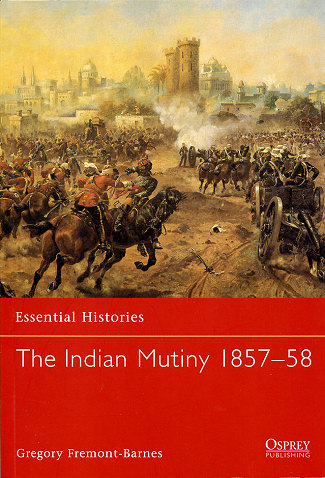 I should
have reviewed this yesterday as it was the 150th anniversary of the start of
this event. It marked a turning point in the British occupation of India as no
longer were things as peaceful and cooperative as they were in the many years
previous.
I should
have reviewed this yesterday as it was the 150th anniversary of the start of
this event. It marked a turning point in the British occupation of India as no
longer were things as peaceful and cooperative as they were in the many years
previous.
There were several things that led up to the unrest. One was
that British officers no longer tried to learn the language or understand the
ways that their Indian troops lived. They didn't care about things like that and
tended to live separate from their men in European enclaves. There was also this
British arrogant superiority in that they felt the Indian people were not worthy
of positions of authority and looked upon them as people who somehow needed to
be ruled. Finally, there was religion. This was probably the largest part of the
puzzle. As happens so often, the British were making an effort to convert the
Indian people from their staple Muslim and Hindu religions over to the totally
alien religion of Christianity. The differences were exacerbated by unfounded
rumors that the troops were being subverted with beef and pork greased
cartridges.
Anyway, once religion gets into the mix, everything else goes
out the window and so the rumors spread through the East India Company
controlled Army, resulting in whole units refusing to follow orders or deserting
over to the cause of the insurgents. The result was a brutal and horrifying
rebellion in which both sides performed unspeakable acts of brutality against
not only the other side's military forces, but against any civilians, including
women and children, who got in their way. In fact, the vast majority of
mutineers were killed in one way or another by the British at the end of the
uprising. This left a lot of bad feelings on both sides, something that, despite
some reforms on the part of the British, never really left the populace and made
their bid for independence after WWII even more of a certainty.
The author takes us through the entire time period by
providing historical origins, then listing the opposing forces and providing the
unredressed grievances that eventually led to the mutiny. Then there is a
chronological portrayal of the war itself; one that became more and more brutal
and bloody. There is a section on one particular officer, Brevet-Major OHSG
Anson of the 9th Lancers to show how the war affected the soldiers. Another is
from the eyes of a British civilian caught in the mess and we hear of Amy Horne
and the massacre at Cownpore. The final months of the war and how the mutiny
affected the state of affairs afterwards. This ends with a look at why the
mutiny failed and British reforms to try to prevent a similar occurance.
Overall, a fascinating look into an important part of British
and world history. A perfect primer for those wanting to know more about this
event and one I can highly recommend.
May 2007
For more on the complete line of Osprey books,
visit www.ospreypublishing.com. In the US, it is
Osprey Direct at 44-02 23rd St, Suite 219, Long Island City, NY 11101., where you can
get a catalogue of available books.
If you would like your product reviewed fairly and quickly by a
site that has over 350,000 visitors a month, please contact
me or see other details in the Note to
Contributors.
 I should
have reviewed this yesterday as it was the 150th anniversary of the start of
this event. It marked a turning point in the British occupation of India as no
longer were things as peaceful and cooperative as they were in the many years
previous.
I should
have reviewed this yesterday as it was the 150th anniversary of the start of
this event. It marked a turning point in the British occupation of India as no
longer were things as peaceful and cooperative as they were in the many years
previous.